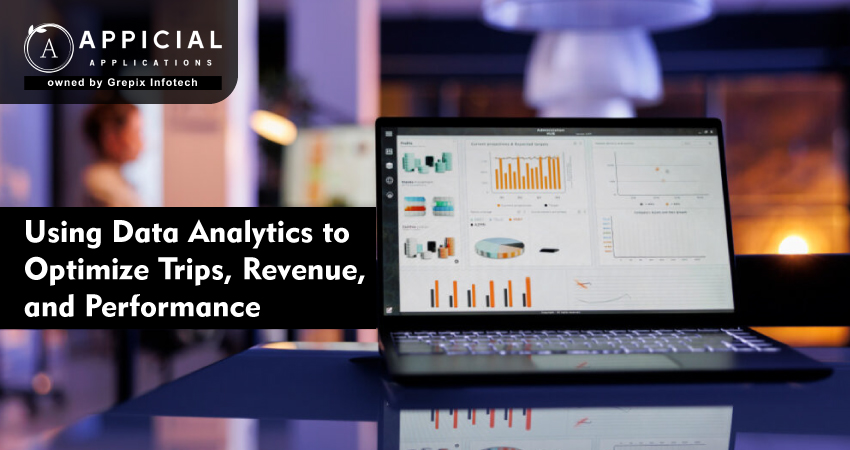
Using Data Analytics to Optimize Trips, Revenue, and Performance
In the fast-moving mobility world, a Uber Clone or other rideshare app must do more than just matching drivers with riders. It must aggregate massive amounts of operational data, trip logs, driver behaviours, rider patterns, surge times and geospatial flows, turning this raw data into insights. A competent taxi app development company creates a white-label taxi booking app that provides you with the software framework.
But analytics turns that framework into a strategy. You can use analytics for optimising trips (idle kms, matching), revenue (dynamic pricing, segmentation) and performance (driver retention, service levels). The ride-sharing market is estimated at USD 106.66 billion in 2023 and is projected to reach USD 480 billion by 2032, growing at a CAGR of ~18.5%. In this context, operational excellence matters.
A white label taxi app development company that provides analytics integration becomes a core partner. This blog will unpack how data analytics drives optimisation across trips, revenue, and performance, specifically for an Uber Clone or ride-sharing app built by a taxi app development company.
In this blog, we explain how analytics can transform a ride-hailing business. We explore the various ways an Uber Clone or ride-sharing application can use analytics to optimise trip routing, pricing, demand forecasting, driver performance, and revenue streams. We talk about which metrics are important, which analytics should be deployed, and how a white-label taxi booking application from a taxi application development company facilitates data-driven development. The conclusion promotes Appicial Applications as the white-label taxi app development company partner you need and invites action.
What key trip metrics should your ride-sharing app track?
For any successful ride-sharing app or Uber Clone, tracking the right metrics is foundational. Without data, you cannot optimise. Key trip metrics include pickup wait time, trip completion time, idle time, trip cancellations, driver repositioning distance, passenger no-shows, rejection rates, and matching success rate.
Pickup wait time measures how long a rider waits after booking. Lower wait times improve customer satisfaction and loyalty. Trip completion time signals how efficient the routing and matching engine are. If drivers take long detours, cost goes up and revenue drops.
Idle time and repositioning distance indicate inefficiencies: drivers waiting or moving without fare-earning trips. Analytics can highlight regions where idle time is disproportionately high, indicating a supply-demand mismatch. Cancellation and no-show rates point to service quality issues or suboptimal matching.
Matching success rate indicates how often a rider request is paired with a driver quickly. In high-demand zones, a robust white-label taxi booking app with real-time analytics can monitor matching and trigger incentives or driver repositioning.
By tracking these metrics continuously via a dashboard from your taxi app development company, you create visibility into the trip ecosystem. That visibility is the prerequisite for optimisation.
How can analytics optimise trip routing and supply-demand matching?
One of the powerful uses of analytics in a ride-sharing application or Uber Clone context, is spatio-temporal modelling of supply and demand. By analyzing historical trip data, clusters of pick-up and drop-off locations, patterns of time-of-day data and driver availability, your system can predict where ride requests will emerge and pre-position drivers accordingly.
Academic research in ride-sharing indicates that using matched trips and historical data can reduce unmatched participants by up to 80% in certain scenarios. Another study found that ride-sharing could serve 20–25% more taxi booking requests and reduce waiting time during peak hours.
In practical terms: your white label taxi app contains location data from each trip. If analytics reveal that between 5pm-7pm on Mondays, there is a surge of requests in downtown and excess idle drivers in adjacent suburbs, the system can alert the driver supply in suburbs to migrate proactively.
Routing optimisation also benefits. By calculating fastest routes, current traffic conditions, and driver‐rider matching, you reduce detour mileage, lower fuel/operating cost, improve earnings and reduce emissions. A taxi app development company that integrates real-time traffic feeds and uses machine-learning prediction models enables these benefits. For example, advanced models can forecast trip durations and idle times based on time, area, weather and events.
Using such analytics proactively separates a strong ride-sharing app from a simple booking platform. It elevates performance, reduces costs, and increases driver utilisation, thereby improving net revenue per vehicle.
How does data analytics drive revenue growth in ride-hailing operations?
Revenue growth is not more rides it is more profitable rides and smarter pricing. For an Uber Clone or ridesharing app, the analytics can allow for dynamic pricing, segmentation, targeted offers etc as other auxiliary revenue streams.
Dynamic pricing first: your system can monitor real time supply and demand imbalances and apply surge pricing or incentives. Historical trip volume, unutilized supply, driver occupancy, and rider no show aggregate data can lead the analytics to predict demand surges and elicit pricing reactions.
Second, segmentation: your analytics can identify high-value riders, frequent riders, long-distance trips, group bookings and premium rides. You can sell loyalty programmes or premium tiers through your white label taxi booking app to increase average revenue per user (ARPU). The taxi app development company should offer modules for segmentation, personalized offers and tracking promotional ROI.
Third, cost management: by reducing empty drives, optimising wait times between pickups, calibrating supply of drivers to demand reduces operational cost which translates into better margins.
Fourth, ancillary revenue: analytics might reveal opportunities for in-vehicle advertising, partnerships (with venues, hotels), or ride-sharing add-ons. In 2024 the revenue for taxi applications reached USD 59.6 billion, with a yearly growth of 27.6% according to new data. That scale shows what analytics can do in terms of optimization.
Therefore, the white label taxi app that a taxi app development company builds must include capabilities for analytics, dashboards, alerts and predictive models. Without that, your Uber Clone will only add volume but will not profitability.
How can performance analytics enhance driver and fleet efficiency?
For the platform, trips and revenue are only part of the equation. Driver satisfaction, fleet utilisation, retention, and maintenance also matter. Analytics plays a key role here.
You can analyze driver performance to see metrics like acceptance rate, completion rate, driver idle time, average earnings per hour, cancellations, rider ratings. If you can identify drivers who are underperforming, or have high cancellation rates, you can intervene with coaching, incentives or reallocation. That improves overall service quality and churn.
Fleet analytics track use, breakdowns, repairs, and the location of vehicles. If you see areas of lower demand or drivers idling too much, you can deploy resources accordingly or downsize the fleet.
From the platform side, connecting driver performance to revenue through earnings per hour or per trip yields a cost-per-unit metric. Analytics can show which routes, neighbourhoods or time blocks are better for driver income and customer satisfaction, helping you refine pricing, driver incentives and scheduling.
The company that builds the taxi app and embeds the dashboards to track fleet performance within the white-label taxi booking services in the app enables the app owner to watch, control, and intervene. Strong analytics in the fleet/driver domain improve reliability, driver engagement and ultimately the customer experience, which contributes to retention and higher lifetime value of riders on your ride-sharing app.
Why should you partner with a white-label taxi app development company with analytics expertise?
Choosing the right development partner matters. A generic app might give you booking and dispatch, but without analytics integrated, you are flying blind. A proper taxi app development company offers not just a white label taxi booking app but also an analytics module, dashboards, custom KPIs and model integrations.
A partner like this understands ride-hailing operations and what metrics matter and brings you the building blocks of analytics: driver scorecards, trip-performance dashboards, demand-forecast modules, pricing-engine hooks. They accelerate time to market, minimize development risk, and provide a scalable architecture.
With a white label taxi app, you will get the UI/UX, apps for drivers and riders, payment integration, admin panels, analytics dashboards, etc, that has already been tested and built for you. Then you grow the business instead of growing the infrastructure from scratch.
Analytics also supports monetisation and optimisation. The data insights from your platform inform decision-making. A good taxi app development company ensures that your analytics capabilities evolve as your business does, new cities, new features, new vehicle types, and new revenue streams.
Learn More: How Local Payment Gateway Integration Enhances Regional Adaptability
How can your analytics strategy stay ahead in a growing market?
The global ride-sharing market is growing rapidly. As noted, the global ride-sharing market size was USD 106.66 billion in 2023 and is expected to reach USD 480 billion by 2032. Similarly, the global taxi market is projected to grow from USD 268.19 billion in 2024 to USD 587.31 billion by 2033 at a CAGR of 9.1%. These numbers highlight opportunity, but also increased competition. To stay ahead, your analytics strategy must evolve.
Real-time analytics: Move from batch reporting to real-time insights and decision-making. Real-time driver repositioning, dynamic pricing, and real-time wait-time alerts elevate your service.
Machine-learning forecasting: As the academic work shows, models using travel impedance variables (cost, distance, duration) have high predictive power for ride-sharing behaviour. One study showed these variables gave 95% predictive power for whether a trip is requested to share. Apply such predictive models in your Uber Clone to anticipate shared-ride demand or surge events.
Multi-modal integration: Your analytics should account for shared rides (pooling), type of vehicle (EV vs petrol), and integrations with public transport. Pooled services improve service uptake: one study has shown that pooling can serve 20-25% more requests and decrease waiting time.
Continuous optimization: A/B testing, monitoring new products (e.g., premium tiers), keeping an eye on driver incentives, and fine-tuning pricing algorithms. Your taxi app development company can support the successive deployment of analytics modules.
Customer analytics: In addition to operational metrics, measure rider satisfaction, feedback, NPS, churn risk, and lifetime value. Perform behavioral analysis to find friction points, drop-off triggers, and develop retention programs.
Benchmark performance: Build a culture of measurement. Define KPIs for trips per hour, idle time, matched rate, revenue per driver, and track against industry benchmarks. With growth ahead in the ride-sharing space, analytics is the differentiator.
Conclusion
In the world of an Uber Clone or full-scale ride-sharing app, data analytics is no longer optional; it is fundamental. Analytics has myriad applications, from optimizing trips (through routing and matching), increasing revenues (through dynamic pricing and segmentation) to augmenting performance (through driver and fleet analytics); the breadth of analytics applications is vast.
To harness this power, you need more than a booking platform; you need a partner. That’s where Appicial Applications comes in. Being a top taxi app development company, Appicial Applications is developing an inclusive white-label taxi booking app including analytics modules, dashboards and predictive models. Whether you are launching a ride-hailing app or moving off legacy systems, they enable rapid deployment, customisation, and scalability for years to come.
Don’t leave your growth to chance. Invest in analytics early. Work with a partner who brings both software and insight. Transform raw data into revenue, efficiency and performance gains.
Reach out to Appicial Applications today to schedule a demo of their white-label solution and analytics capability. Take the first step to optimise trips, boost revenue and maximise your ride-hailing performance. Your data-driven journey begins now.
FAQs
Author's Bio

Vinay Jain is the Founder at Grepix Infotech and brings over 12 years of entrepreneurial experience. His focus revolves around software & business development and customer satisfaction.
Back to blog list




